Though small and hardly visible to the naked eye, the Emerald Ash Borer beetle has had a significant impact on Wisconsin, damaging and killing trees and destabilizing the state’s natural environment.
Nine years after the initial detection of the invasive Emerald Ash Borer, the infestation now covers the lower two-thirds of the state and has pushed the Wisconsin Department of Agriculture, Trade and Consumer Protection to place many counties under quarantine.
Phil Townsend, professor of forest ecology at the University of Wisconsin, said the Emerald Ash Borer is causing lots of damage to ash trees in particular.
“In natural forests, ash are a small but important component of the forest,” Townsend said. “It would be a shame to lose ash.”
Townsend and his team’s research has focused on mapping the distribution of ash trees in natural forests and the Madison area. The team is also looking at the likely effects of their death due to growing Emerald Ash Borer infestations.
The Emerald Ash Borer is expected to cause as much as a 30 percent loss of tree canopy in the city and change the feel of many neighborhoods.
“People like leafy neighborhoods with bigger, older trees,” Townsend said. “That will go away.”
Ash trees also make up 20 to 30 percent of the forest cover in urban areas. Their death will result in a loss of the habitat they provide, reduce energy usage in the summer and reduce carbon dioxide intake. It will also lead to fewer windbreaks in the winter and reduce interception of rainfall and runoff, Townsend said.
A lack of ash trees also means there will be less diversity in the natural forests and less wood for timber, Townsend said. Ash wood is used in baseball bats as well as tool and implement handles.
The Emerald Ash Borer is a big risk in black ash forests in wetlands as well. Ash trees take up water and maintain the wetland ecosystem.
There are not many other trees that can replace ash trees and without them, wetlands could become wetter and flood, Townsend said. Managing the flooding would be a hassle for ecosystem services in the state.
Control sprays do not affect Emerald Ash Borers and ash trees have no natural defenses, Townsend said.
“Once [the Emerald Ash Borers are] here, the ash trees are toast,” Townsend said. “And it’s here.”
Donna Gilson, Wisconsin DATCP spokesperson, said firewood encourages the beetle species to spread. DATCP places traps in areas where they are predicted to spread, monitors woodpecker activity and finds areas where damage is present to try to control its growth.
“The larvae of the species is under the bark of trees throughout the winter until they develop and come out in the spring,” Gilson said. “Woodpeckers will know there is food under the tree and will begin pecking at the tree.”
DATCP places a county under quarantine if the Emerald Ash Borer is found there, Gilson said. This quarantine mandates businesses that deal with wood products in the county have to develop an agreement with the U.S. Department of Agriculture. The USDA then explains exactly what measures the business will take to continue their work without risking the movement of the species to an uninfected area, she said.
The quarantine also prohibits individuals in the area from moving firewood to areas which are not yet infected, Gilson said. This means people should be aware of the Emerald Ash Borer and how to identify it in trees.
Townsend said researchers are taking a variety of approaches to nip the spread of the Emerald Ash Borer. One is the introduction of a parasitic wasp that preys on Emerald Ash Borer, Townsend said. The other is to breed resistant trees.
A Wisconsin DATCP map shows which counties are currently under quarantine. In many of the counties under quarantine, the species has only been detected once, Gilson said.
“We encourage people … even though their county may be under quarantine, they must still be careful because they can still slow things down,” Gilson said.


